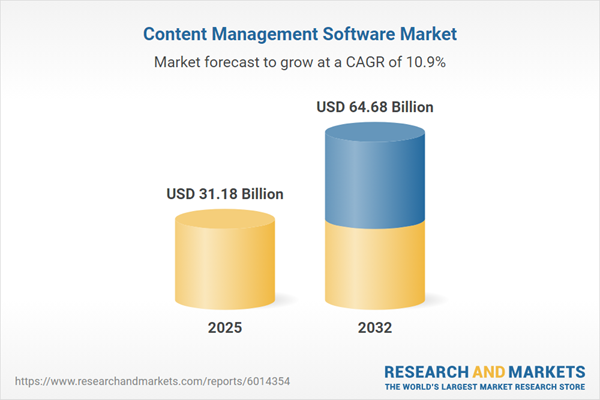Speak directly to the analyst to clarify any post sales queries you may have.
The global content management software market is advancing rapidly as organizations address increasing volumes of digital data, operational complexity, and evolving compliance demands. Strategic investment in superior solutions now drives innovation, efficiency, and sustained differentiation across industries.
Market Snapshot: Content Management Software Market Size and Growth
The Content Management Software Market grew from USD 28.33 billion in 2024 to USD 31.18 billion in 2025. It is expected to continue expanding at a CAGR of 10.86%, reaching USD 64.68 billion by 2032. This trajectory signals robust, ongoing demand for enterprise-grade platforms that enable secure, scalable, and seamless information management, underscoring the necessity for business leaders to remain proactive in digital transformation strategies.
Scope & Segmentation: Strategic Dimensions of the Content Management Software Market
Comprehensive segmentation and regional analysis are essential for senior executives evaluating growth avenues and operational risks. This report addresses the following market segments and coverage areas:
- Components: Software, Managed Services, Professional Services
- Deployment Modes: Cloud (Private Cloud, Public Cloud), On-Premises
- Organization Sizes: Large Enterprises, Small and Medium-Sized Enterprises
- Applications: Case Management, Digital Asset Management (DAM), Document Management, Imaging & Capturing, Mobile Content Management, Records Management, Web Content Management (WCM)
- End Users: Banking Financial Services and Insurance, Government and Public Sector, Healthcare and Life Sciences, IT and Telecom, Media and Entertainment, Retail and Ecommerce
- Regions: Americas, Europe, Middle East, Africa, Asia-Pacific
- Leading Companies: Adobe Inc., Oracle Corporation, SAP SE, OpenText Corporation, IBM Corporation, Sitecore Corporation A/S, Acquia, Optimizely, Crownpeak, Liferay, GoDaddy, Zoho, Joomla, HubSpot, Contentful, Contentstack, Jahia Solutions Group, Hyland Software, BigCommerce, Elementor, Pixel & Tonic, DNN Corp., Kentico Software
Key Takeaways for Strategic Decision-Makers
- Content management software has become foundational for organizations engaging in large-scale digital information handling spanning mobile, cloud-native, and collaborative environments.
- Emerging technologies such as artificial intelligence and API-first architectures are transforming traditional repositories into platforms that deliver automated analytics and advanced metadata management.
- Decentralized workforces and heightened data security demands are accelerating integration with zero-trust security models and modern audit trails, including blockchain technologies.
- Sustainability credentials and responsible data governance increasingly influence vendor selection as environmental, social, and governance pressures gain prominence in procurement processes.
- Market segmentation highlights varying adoption trends by sector, from finance and healthcare with their emphasis on compliance, to retail and media prioritizing content personalization and engagement.
- The ongoing interplay between legacy system modernization and modular, cloud-driven deployments enables tailored strategies for organizations regardless of their digital maturity.
Assessing Tariff Impact: Supply Chain & Cost Dynamics
Recent United States tariff adjustments have introduced strategic challenges, altering procurement and supply chain practices for both software and related hardware partners. Vendors are revising sourcing strategies and collaborating closely with infrastructure suppliers to balance costs. Professional and managed services providers are adopting flexible resource approaches, such as nearshoring and hybrid models, to sustain delivery efficiency and address compliance.
Methodology & Data Sources
The findings in this content management software market report are derived from a blend of secondary research—drawing on industry journals, regulatory filings, and market white papers—and primary research conducted with stakeholders from vendors, end users, and subject matter experts. Data triangulation, proprietary models, and multiple review cycles ensure analytic rigor and integrity of insights.
Why This Report Matters: Informed Guidance for Senior Leaders
- Gain an actionable framework to evaluate technology investments, operational workflows, and compliance strategies across regions and verticals.
- Understand the latest market drivers, including the impact of emerging technologies, geopolitical shifts, and supply chain resilience considerations.
- Access competitive intelligence about key industry players, innovations, and evolving customer expectations to support targeted growth planning.
Conclusion: Navigating the Future of Content Management Software
Senior executives can position their enterprises for lasting advantage by aligning content management strategies with broader digital initiatives. Adapting to shifting technology, regulatory, and geopolitical terrains is critical for transforming information management into a competitive asset.
Additional Product Information:
- Purchase of this report includes 1 year online access with quarterly updates.
- This report can be updated on request. Please contact our Customer Experience team using the Ask a Question widget on our website.
Table of Contents
3. Executive Summary
4. Market Overview
7. Cumulative Impact of Artificial Intelligence 2025
Companies Mentioned
The companies profiled in this Content Management Software market report include:- Adobe Inc.
- Oracle Corporation
- SAP SE
- OpenText Corporation
- IBM Corporation
- Sitecore Corporation A/S
- Acquia, Inc.
- Optimizely, Inc.
- Crownpeak Technology, Inc.
- Liferay, Inc.
- GoDaddy Inc.
- Zoho Corporation Pvt. Ltd.
- Joomla By Open Source Matters, Inc.
- HubSpot, Inc.
- Contentful, Inc.
- Contentstack, Inc.
- Jahia Solutions Group
- Hyland Software, Inc.
- BigCommerce Holdings, Inc.
- Elementor Ltd.
- Pixel & Tonic, Inc.
- DNN Corp.
- Kentico Software
Table Information
| Report Attribute | Details |
|---|---|
| No. of Pages | 186 |
| Published | November 2025 |
| Forecast Period | 2025 - 2032 |
| Estimated Market Value ( USD | $ 31.18 Billion |
| Forecasted Market Value ( USD | $ 64.68 Billion |
| Compound Annual Growth Rate | 10.8% |
| Regions Covered | Global |
| No. of Companies Mentioned | 24 |









